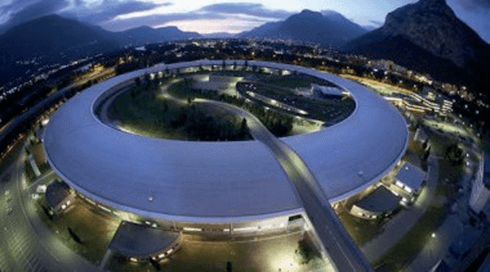Sponsored by HORIBAJun 12 2018
There are a range of light sources that can be used within Vacuum Ultra Violet Spectroscopy systems, though the most commonly used ones are the synchrotron, free electronic laser and laser-produced plasma light sources. Each of these is explored further, below.
Synchrotron (SR)
Synchrotron radiation facilities can deliver powerful continuum radiation from the microwave (specifically harmonics of the driving RF field) to the X-ray spectral regions. These are produced by high energy electrons, centripetally accelerated within the magnetic fields of a storage ring. These beams are then quasi-collimated and polarized.

Figure 1. ESRF Synchrotron in Grenoble (France)
There are fewer than a hundred synchrotron facilities globally, though this is by far the most powerful light source ever built, and perhaps the most expensive too. Synchrotron facilities are huge in terms of size with each being several hundred meters in diameter and delivering a powerful Ultra High Vacuum environment thanks to their complex operating systems.
Free Electron Laser (FEL)
The Free Electron Laser (FEL) is the fourth generation of synchrotron technology. This type of laser uses electrons that are accelerated to the speed of light before crossing an extremely long undulator – a linear array made with magnets. Because the magnet’s polarities alternate, the path of the electrons becomes sinusoidal. This results in the production of radiation.
FELs have a number of similarities with the more complex synchrotrons such as their powers, emissions regions, sizes and relative costs. Additionally, these lasers can be tuned to work on a range of spectra from microwave to X-ray.
Laser-Produced Plasmas (LPP)
Laser-Produced Plasmas are created when a powerful pulse laser is focused onto a solid target. During this process a high-density (~1021 cm-3) and high-temperature (50~100 eV) plasma is created, existing for just a few nanoseconds.

Figure 2.UVS-300 Plasma discharge source
Certain target materials produce a strong VUV quasi-continuum that is largely full of discrete lines, and the continua are more intense in the 4 to 30 nm region, but regularly reaching up to 180 nm. This process offers better results when using the rare earth elements from the periodic table, or their neighboring metals.
LPP offer a limited emission range in contrast with the other methods discussed here, so these are generally used within the semiconductor industry (microlithography) and within astronomy.
Arcs, Sparks and Discharges
A number of VUV light sources emit continuum radiations and/or VUV lines. These are based on high pressure arcs, gas discharges, low pressure and vacuum sparks.
These particular sources offer low cost and portability but are not as intense as laser-induced plasmas or synchrotron radiation. Available options include:-
- Ar mini-Arc: from near UV to approximately 115 nm
- H2 and D2 Discharges: 115~350 nm, bulb material dependent
- Inert Gas Discharges: Plasma discharges generated through He, Ar, Kr, and Xe cover mainly the 20 to 700 nm region. Some available designs are pumped hollow cathode, Capillary Plasma, Penning or Damany source.
| . |
. |
. |
| Deuterium |
115-400 nm |
Continuum with broadband pics |
| Hydrogen |
115-700 nm |
Continuum with broadband pics |
| Argon Mini-Arc |
115-700 nm |
Continuum with broadband pics |
| Hollow cathode |
25-200 nm |
Emission pics (gas dependent) Plasma |
| Plasma Discharge (gas dependent) |
20-700 nm |
Emission pics (gas dependent) |

This information has been sourced, reviewed and adapted from materials provided by HORIBA.
For more information on this source, please visit HORIBA.